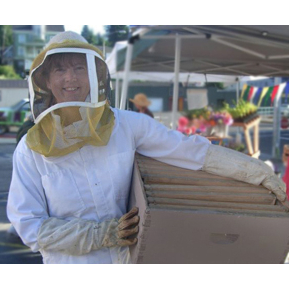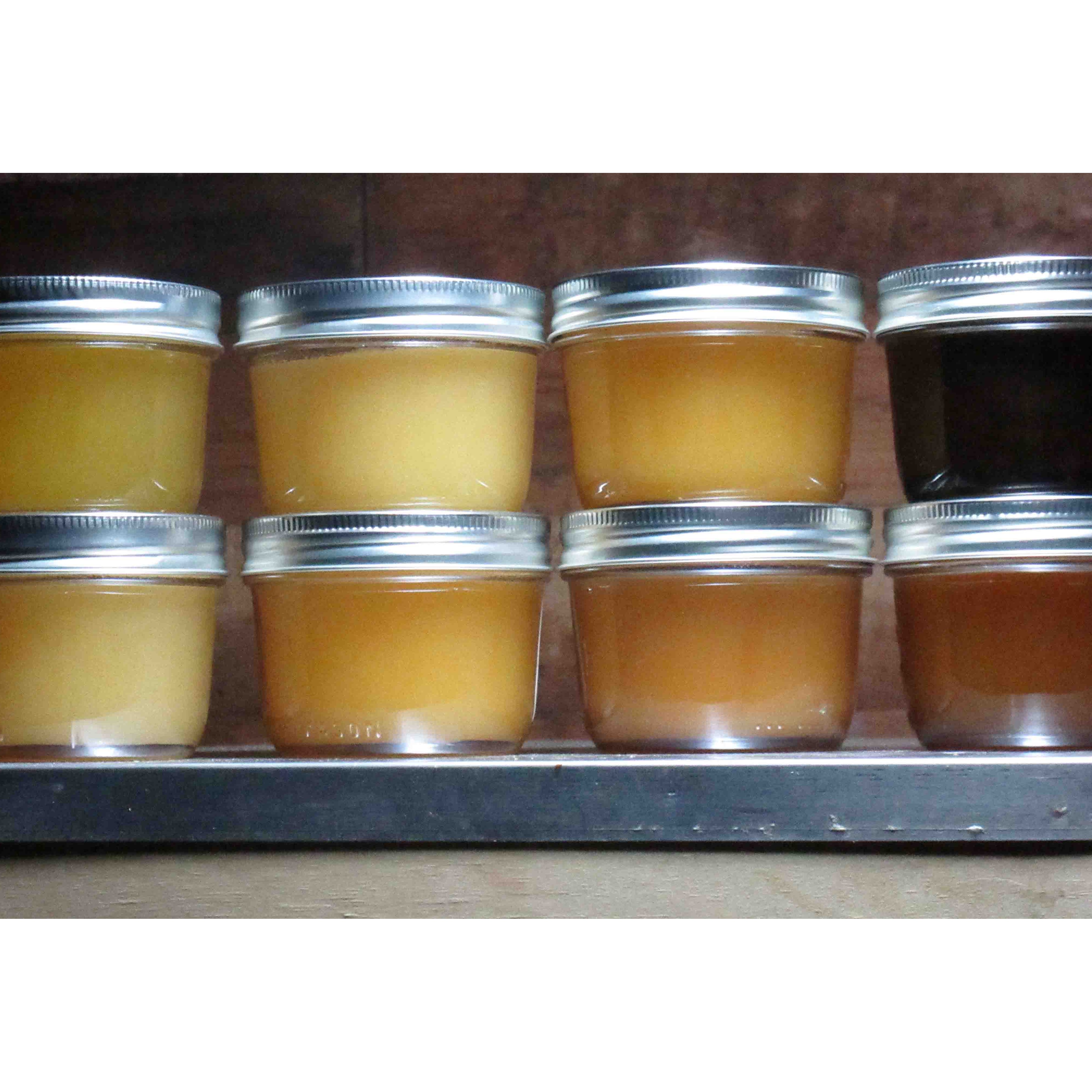Producer


Bee Haven Apiaries
Contact: Julie Tennis
City: Naselle, WA, 98638
Phone: 360-484-7870
Website: https://www.beementor.com/
About Us
Bee Haven Apiaries is a boutique beekeeping business specializing in small run, limited edition seasonal and site-specific honeys. We have apiaries in Clatsop, Pacific, and Wahkiakum Counties. Bee Haven Apiaries started in 2008, running what the owner, Julie Tennis, refers to as "honeybee retirement communities." While most beekeepers manage their colonies for honey production or pollination services, Julie lets the bees live out their lives naturally, in small apiaries that are lightly managed. Every care is taken not to injure the bees. Most of the honey is left for the bees so they have food to overwinter. Julie sells excess honey to help subsidize the cost of maintaining these colonies.
Julie's bees are not fed sugar or sugar water, so all the honey produced by her colonies is 100% flower nectar. This means more flavor and better tasting honey that is healthier for you and the bees.
Honey from Bee Haven Apiaries is removed from the hive using a hand-cranked extractor. The only "processing" it receives is being poured through a sieve to remove any wax and propolis before being placed into heat-sterilized jars. The honey is never heated, and every batch of honey is processed separately. This preserves the unique colors, flavors and aromas of each colony's production.
Since Julie doesn't pasteurize her honey, it may crystallize or ferment when stored. These are natural processes that can add character to the honey. Crystallized honey is just as delicious and carries the same health benefits as liquid honey. Fermented honey has an extra little "buzz" that adds a sharpness to the flavor. Read on for more information about these processes and how to halt them.
Why Does Honey Crystallize?
The main constituents of honey are fructose and glucose. Both fructose and glucose are simple sugars, created when the honeybees partially-digest nectar from flowers. The honey becomes super-saturated as the bees fan the liquid with their wings, reducing the moisture content from 90% to below 18%. When the honey has reached the desired viscosity, the workers cover the cell with a layer of wax to keep the honey from reabsorbing water from the atmosphere.
Each plant produces nectar with different characteristics. When processed into honey, this translates into different ratios of fructose to glucose. Fructose is more soluble than glucose, so honey with a higher fructose content is slower to crystallize. Glucose is less stable and will eventually drop out of suspension, creating crystals. The faster the honey crystallizes, the smaller the crystals will be.
What Are Those Feathery Patterns in the Honey?
One of the by-products of crystallization can be fermentation. When the glucose drops out of suspension, the relative moisture content of the non-crystallized honey rises. This allows the naturally occurring yeasts in the honey to begin consuming the remaining sugars. In small-grained crystallized honey, like what we often see from our Grays River apiary, the crystallization process happens so quickly that the yeast doesn’t have time to convert the entire jar. Instead, you will see long feathery patterns on the sides or a thin, lighter color “bloom” on the surface of your honey. These converted areas have a slightly chewier texture and a sweeter flavor than the rest of the honey. In honeys that crystalize more slowly, fermentation can affect the entire jar, causing gas bubbles to form, creating a foaming texture and adding a sharp, yeasty flavor to the honey. This honey is also still good to eat. Some folks liken it to kombucha.
Are Crystallized and Fermented Honeys Safe to Eat?
Yes! In fact, crystallization and fermentation are proof that the honey you are buying is real, raw honey. There are no additives, such as corn syrup, and this honey hasn’t been ultra-filtered (which removes healthful pollen grains) or pasteurized (which destroys beneficial enzymes).
If you want to re-liquefy your honey, boil a pot of water, take the pot off the burner, then set your jar of honey in the hot water (do not submerge the jar). This can be a lengthy process, but it will re-liquefy your honey while retaining some of the beneficial enzymes. If you want to melt your honey more quickly, you can use the microwave (make sure you remove the metal lid first). Note that using the microwave will destroy the beneficial enzymes and reduces the shelf-life of your honey.
Storing Honey
All honey is hygroscopic, meaning it will absorb moisture from the air. It is important to keep your honey sealed when not in use. If you leave the jar exposed to air, it will absorb moisture, which will allow the naturally-occurring yeast to come out of dormancy and ferment your honey. To stop honey from fermenting, store it in the refrigerator or freezer (or someplace that is consistently below 50-degrees F).
A Final Note About Honey
ALL honey may contain naturally-occurring Clostridium botulinum spores, which can cause infant botulism. Heating does not destroy these spores. Do not feed honey to children under 12 months old nor to people with compromised immune systems.
Wax
Are you looking for raw beeswax? Contact Julie at beementor@gmail.com for pricing.
Julie's bees are not fed sugar or sugar water, so all the honey produced by her colonies is 100% flower nectar. This means more flavor and better tasting honey that is healthier for you and the bees.
Honey from Bee Haven Apiaries is removed from the hive using a hand-cranked extractor. The only "processing" it receives is being poured through a sieve to remove any wax and propolis before being placed into heat-sterilized jars. The honey is never heated, and every batch of honey is processed separately. This preserves the unique colors, flavors and aromas of each colony's production.
Since Julie doesn't pasteurize her honey, it may crystallize or ferment when stored. These are natural processes that can add character to the honey. Crystallized honey is just as delicious and carries the same health benefits as liquid honey. Fermented honey has an extra little "buzz" that adds a sharpness to the flavor. Read on for more information about these processes and how to halt them.
Why Does Honey Crystallize?
The main constituents of honey are fructose and glucose. Both fructose and glucose are simple sugars, created when the honeybees partially-digest nectar from flowers. The honey becomes super-saturated as the bees fan the liquid with their wings, reducing the moisture content from 90% to below 18%. When the honey has reached the desired viscosity, the workers cover the cell with a layer of wax to keep the honey from reabsorbing water from the atmosphere.
Each plant produces nectar with different characteristics. When processed into honey, this translates into different ratios of fructose to glucose. Fructose is more soluble than glucose, so honey with a higher fructose content is slower to crystallize. Glucose is less stable and will eventually drop out of suspension, creating crystals. The faster the honey crystallizes, the smaller the crystals will be.
What Are Those Feathery Patterns in the Honey?
One of the by-products of crystallization can be fermentation. When the glucose drops out of suspension, the relative moisture content of the non-crystallized honey rises. This allows the naturally occurring yeasts in the honey to begin consuming the remaining sugars. In small-grained crystallized honey, like what we often see from our Grays River apiary, the crystallization process happens so quickly that the yeast doesn’t have time to convert the entire jar. Instead, you will see long feathery patterns on the sides or a thin, lighter color “bloom” on the surface of your honey. These converted areas have a slightly chewier texture and a sweeter flavor than the rest of the honey. In honeys that crystalize more slowly, fermentation can affect the entire jar, causing gas bubbles to form, creating a foaming texture and adding a sharp, yeasty flavor to the honey. This honey is also still good to eat. Some folks liken it to kombucha.
Are Crystallized and Fermented Honeys Safe to Eat?
Yes! In fact, crystallization and fermentation are proof that the honey you are buying is real, raw honey. There are no additives, such as corn syrup, and this honey hasn’t been ultra-filtered (which removes healthful pollen grains) or pasteurized (which destroys beneficial enzymes).
If you want to re-liquefy your honey, boil a pot of water, take the pot off the burner, then set your jar of honey in the hot water (do not submerge the jar). This can be a lengthy process, but it will re-liquefy your honey while retaining some of the beneficial enzymes. If you want to melt your honey more quickly, you can use the microwave (make sure you remove the metal lid first). Note that using the microwave will destroy the beneficial enzymes and reduces the shelf-life of your honey.
Storing Honey
All honey is hygroscopic, meaning it will absorb moisture from the air. It is important to keep your honey sealed when not in use. If you leave the jar exposed to air, it will absorb moisture, which will allow the naturally-occurring yeast to come out of dormancy and ferment your honey. To stop honey from fermenting, store it in the refrigerator or freezer (or someplace that is consistently below 50-degrees F).
A Final Note About Honey
ALL honey may contain naturally-occurring Clostridium botulinum spores, which can cause infant botulism. Heating does not destroy these spores. Do not feed honey to children under 12 months old nor to people with compromised immune systems.
Wax
Are you looking for raw beeswax? Contact Julie at beementor@gmail.com for pricing.
Practices
Located less than 20 miles from the North Coast Food Web.
